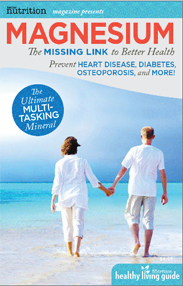Optimum Calcium Magnesium Ratio
The 2-to-1 Calcium-to-Magnesium Ratio
By A. Rosanoff, PhD, Director of Research & Science
Information Outreach, Center for Magnesium Education &
Research, LLC, www.MagnesiumEducation.com
Some History
As early as 1964, Dr. Mildred Seelig showed that calcium intake can be a factor in the body’s retention of dietary magnesium.1 This magnesium pioneer later considered the possible impact of high calcium with low magnesium intakes on heart and blood-vessel health,2, 3 and her predictive work was shown to be a serious consideration in 1978 when a population’s calcium-to-magnesium intake ratio was found to be associated with rates of heart disease death.4
The Two-to-One Ratio
The 2-to-1 calcium-to-magnesium ratio (2:1) was first suggested by the French magnesium researcher Jean Durlach as a high limit not to be exceeded, when he warned against excessive calcium relative to magnesium intakes; that is, one’s calcium intake from all sources including food, water and supplements should not exceed one’s total magnesium intake by more than 2 parts calcium to 1 part magnesium on a weight basis. 5
Thus, if one’s total magnesium intake per day is 300 mg, one’s total calcium intake for that day should not exceed 600 mg, according to Durlach. This would be a high level of calcium for the level of magnesium, not to be exceeded, according to this early and often-quoted recommendation. A lower calcium-to-magnesium ratio is thus safe, such as a one-to-one ratio or even less in some times of life or therapy.
It is important to note that this ratio is for weights of elemental calcium and elemental magnesium, not the weights of their compounds. It is also for all sources of calcium and magnesium intakes including food, water and supplements.
Calcium Cannot Be Optimally Utilized Without a Proper Balance of Magnesium
Magnesium and calcium are two sides of a physiological coin: they are antagonistic to one another yet operate as a team.
For example:
• Calcium exists mainly outside the cells, whereas almost all magnesium is found inside the cells.
• Calcium excites nerves; magnesium calms them down.
• Calcium with potassium makes muscles contract, but magnesium is necessary for muscles to relax.
• Calcium is necessary to the clotting reaction—essential for wound healing—but magnesium keeps the blood flowing freely and prevents abnormal thickening when clotting reactions would be dangerous.
• Calcium is mostly found in the bones and gives them much of their hardness, whereas magnesium is found mainly in soft structures. Bone matrix, the soft structure within bone, contains protein and magnesium and gives the bones some flexibility and resistance to brittleness.6
Without Adequate Magnesium, Too Much Calcium May Cause Damage to the Cells and the Body
Scientific study shows more and more that the underlying cellular change enabling the “fight or flight” stress response in the body is a low magnesium-to-calcium ratio caused by a large and sudden influx of calcium into the cells. The stress response subsides when the cells’ magnesium returns to its dominant presence inside the cells, moving extra calcium back to its “normal” position, thus restoring the cells’ natural ratio.
A low magnesium condition can be exacerbated by a high intake of calcium—promoted heavily today by many health professionals. Calcium cannot be optimally utilized without a proper balance of magnesium, and a high calcium intake without adequate magnesium nutrition and/or status can further drain any reserves of magnesium. Calcium is necessary at the cellular level for muscles to contract, for nerves to fire, for hormones to be secreted, and for the inflammation response to initiate. But calcium needs to be balanced with magnesium. If you take in too much calcium and too little magnesium over an extended time period and a cellular/physiological imbalance between calcium and magnesium occurs, what can happen is the excited firing state of biochemistry of the cell will tend to remain that way. In a stress situation, such as exercising more vigorously than usual or when someone is suddenly and unexpectedly frightened, muscle cells, nerve cells, hormone secreting cells or the inflammation response can go into an overreaction mode—the fight or flight mode. Without magnesium they don’t come back down to a resting state; they stay excited in that firing mode.
If calcium levels inside a cell get especially high because of low magnesium, the cell physically changes. High calcium tends to make things stiff and hard. But if soft tissue begins to get hard, it is a problem—the problem of calcification. In artery and heart cells, the stiffness caused by calcification hampers proper function and can lead to heart disease.
Calcium is an important essential nutrient, but it must be balanced by adequate magnesium or it may cause damage to the cells and the body as a whole.
Can there be too much magnesium and too little calcium? Of course. In this age of highly processed foods and the liberal use of essential nutrient supplementation, imbalances are always possible. A practicing physician or health professional must always be open to this possibility. This is especially difficult, as symptoms of “too much” of an essential nutrient often mimic symptoms brought on by “too little” of the same nutrient. But at this time, with a largely low magnesium diet and a general recommendation, especially to women, that they supplement their calcium, the imbalance of too much calcium to too little magnesium is one to regularly consider.7
References
1. Seelig, M. S. 1964. “The Requirement of Magnesium by the Normal Adult. Summary and Analysis of Published Data.” Am J Clin Nutr 14: 242–90. http://www.ncbi.nlm.nih.gov/pubmed/14168977.
2. Seelig, M. S. 1971. “Human Requirements of Magnesium; Factors That Increase Needs.” 1er Symposium International sur le Deficit Magnesique en Pathologie Humaine. Vittel, France. Ed. J. Durlach.
3. Seelig, M. S., and H. A. Heggtveit. 1974. “Magnesium Interrelationships in Ischemic Heart Disease: a Review.” Am J Clin Nutr 27(1): 59–79. http://www.ncbi.nlm.nih.gov/entrez/query.fcgi?cmd=Retrieve&db=PubMed&dopt=Citation&list_uids=4588182.
4. Karppanen, H., R. Pennanen, et al. 1978. “Minerals, Coronary Heart Disease and Sudden Coronary Death.” Adv Cardiol 25: 9–24. http://www.ncbi.nlm.nih.gov/entrez/query.fcgi?cmd=Retrieve&db=PubMed&dopt=Citation&list_uids=360793.
5. Durlach, J. 1989. “Recommended Dietary Amounts of Magnesium: Mg RDA.” Magnes Res 2(3): 195–203. http://www.ncbi.nlm.nih.gov/entrez/query.fcgi?cmd=Retrieve&db=PubMed&dopt=Citation&list _uids=2701269.
6. Seelig, M. S., and A. Rosanoff. 2003. The Magnesium Factor. New York: Avery Penguin Group.
7. Rosanoff, A., C. Weaver, et al. 2012. “Suboptimal Magnesium Status in the United States: Are the Health Consequences Underestimated?” Nutrition Reviews 70(3): 153–64.
Newsletter
![]()

Want valuable information regarding the health benefits of magnesium, latest studies, expert interviews,videos and health tips? Enter your name and email address and you can start receiving valuable health information right away.
Featured On:








